Page 398 of 634
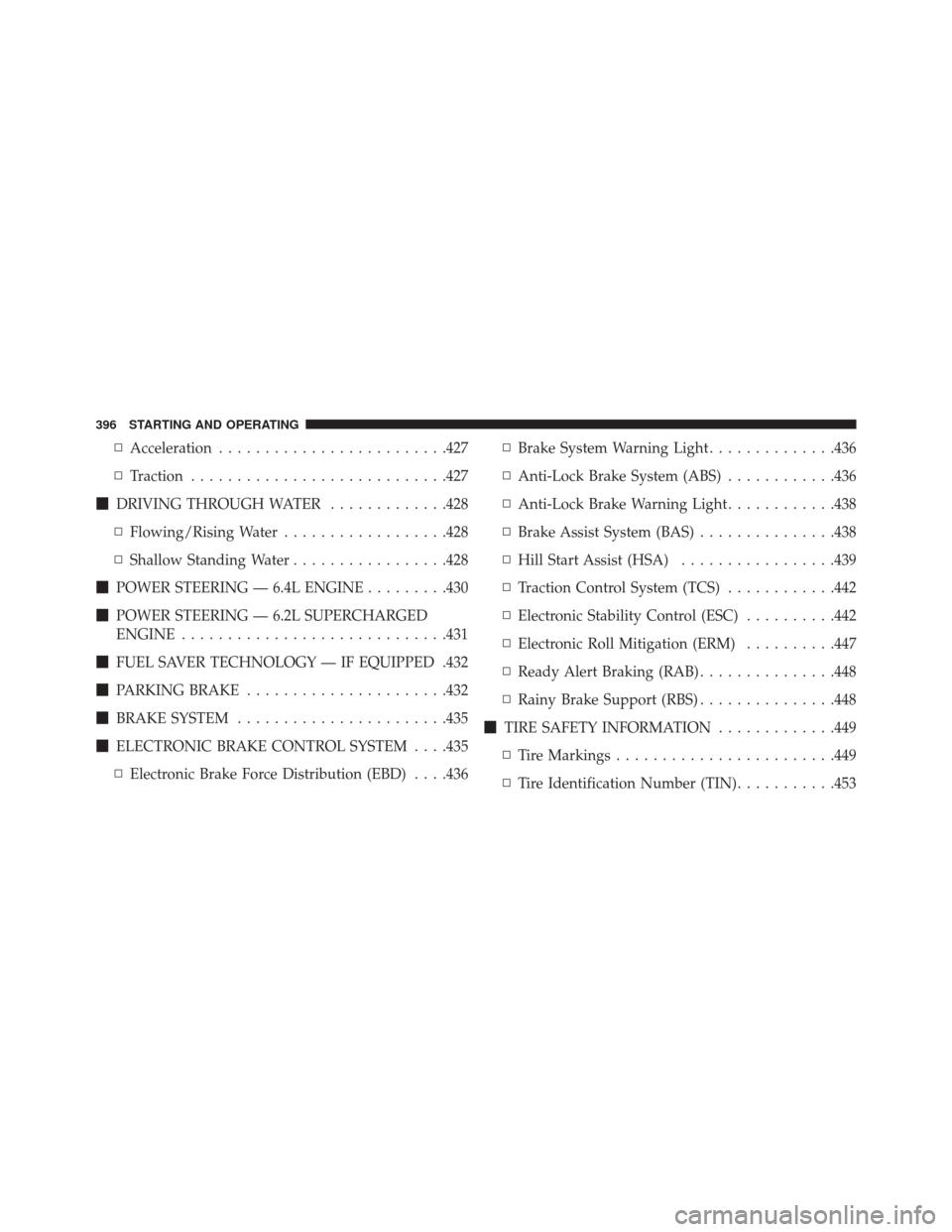
▫Acceleration ........................ .427
▫ Traction ........................... .427
� DRIVING THROUGH WATER .............428
▫ Flowing/Rising Water ..................428
▫ Shallow Standing Water .................428
� POWER STEERING — 6.4L ENGINE .........430
� POWER STEERING — 6.2L SUPERCHARGED
ENGINE ............................ .431
� FUEL SAVER TECHNOLOGY — IF EQUIPPED .432
� PARKING BRAKE ..................... .432
� BRAKE SYSTEM ...................... .435
� ELECTRONIC BRAKE CONTROL SYSTEM . . . .435
▫ Electronic Brake Force Distribution (EBD) . . . .436 ▫
Brake System Warning Light ..............436
▫ Anti-Lock Brake System (ABS) ............436
▫ Anti-Lock Brake Warning Light ............438
▫ Brake Assist System (BAS) ...............438
▫ Hill Start Assist (HSA) .................439
▫ Traction Control System (TCS) ............442
▫ Electronic Stability Control (ESC) ..........442
▫ Electronic Roll Mitigation (ERM) ..........447
▫ Ready Alert Braking (RAB) ...............448
▫ Rainy Brake Support (RBS) ...............448
� TIRE SAFETY INFORMATION .............449
▫ Tire Markings ....................... .449
▫ Tire Identification Number (TIN) ...........453
396 STARTING AND OPERATING
Page 419 of 634
DRIVE MODES
Your SRT vehicle is equipped with a SRT Drive Mode
feature. This feature gives the driver control over the
systems in the vehicle which affect its performance,
enabling the driver to tune it for desired driving sce-
narios. Below are the modes of operation:
NOTE:Refer to “Drive Modes” in “Understanding Your
Instrument Panel” for further descriptions of these
modes.
•TRACK MODE — This mode is a predefined configu-
ration optimized for typical track driving. The ABS,
Transmission, Steering, and Suspension systems are all
set to their TRACK settings. Steering wheel mounted
paddle shifters are enabled.
Drive Modes
5
STARTING AND OPERATING 417
Page 420 of 634
•SPORT MODE — This mode is a predefined configu-
ration optimized for typical enthusiast driving. The
ABS, Transmission, Steering, and Suspension systems
are all set to their SPORT settings. Steering wheel
mounted paddle shifters are enabled.
• CUSTOM MODE — This mode allows the driver to
create a custom vehicle configuration that is saved for
quick selection of favorite settings. The system will
return to Default mode when the ignition switch is
cycled from RUN to OFF to RUN, if this mode is
selected. While in Custom Mode the Traction, Trans-
mission, Steering, Suspension and Paddle shifter set-
tings may be configured through the custom mode
set-up in any combination. Listed below is a description of each of these settings:
Transmission (Trans)
•
Track — provides the fastest shift speeds and has the
highest comfort trade-off.
Custom Mode Set-Up
418 STARTING AND OPERATING
Page 422 of 634
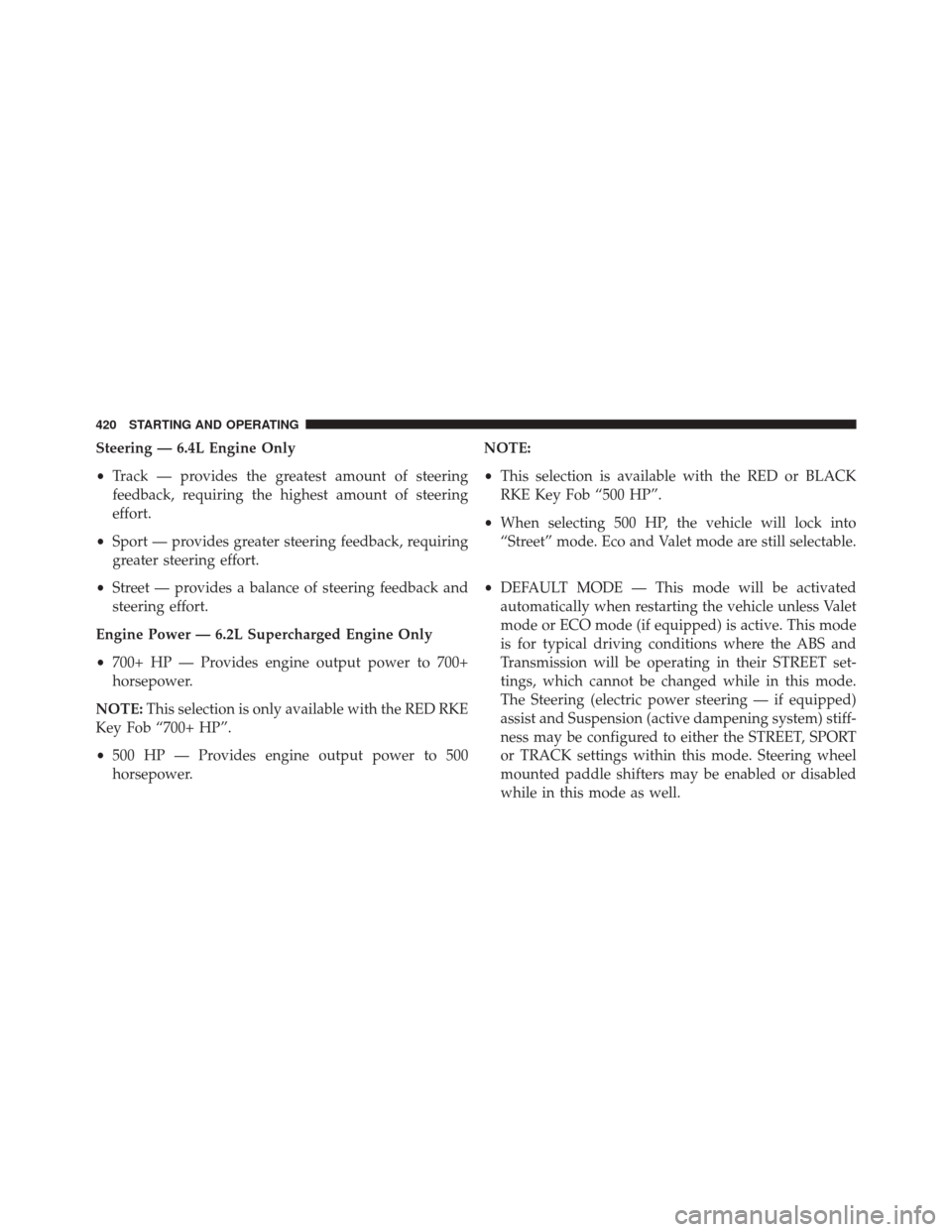
Steering — 6.4L Engine Only
•Track — provides the greatest amount of steering
feedback, requiring the highest amount of steering
effort.
• Sport — provides greater steering feedback, requiring
greater steering effort.
• Street — provides a balance of steering feedback and
steering effort.
Engine Power — 6.2L Supercharged Engine Only
• 700+ HP — Provides engine output power to 700+
horsepower.
NOTE: This selection is only available with the RED RKE
Key Fob “700+ HP”.
• 500 HP — Provides engine output power to 500
horsepower. NOTE:
•
This selection is available with the RED or BLACK
RKE Key Fob “500 HP”.
• When selecting 500 HP, the vehicle will lock into
“Street” mode. Eco and Valet mode are still selectable.
• DEFAULT MODE — This mode will be activated
automatically when restarting the vehicle unless Valet
mode or ECO mode (if equipped) is active. This mode
is for typical driving conditions where the ABS and
Transmission will be operating in their STREET set-
tings, which cannot be changed while in this mode.
The Steering (electric power steering — if equipped)
assist and Suspension (active dampening system) stiff-
ness may be configured to either the STREET, SPORT
or TRACK settings within this mode. Steering wheel
mounted paddle shifters may be enabled or disabled
while in this mode as well.
420 STARTING AND OPERATING
Page 428 of 634
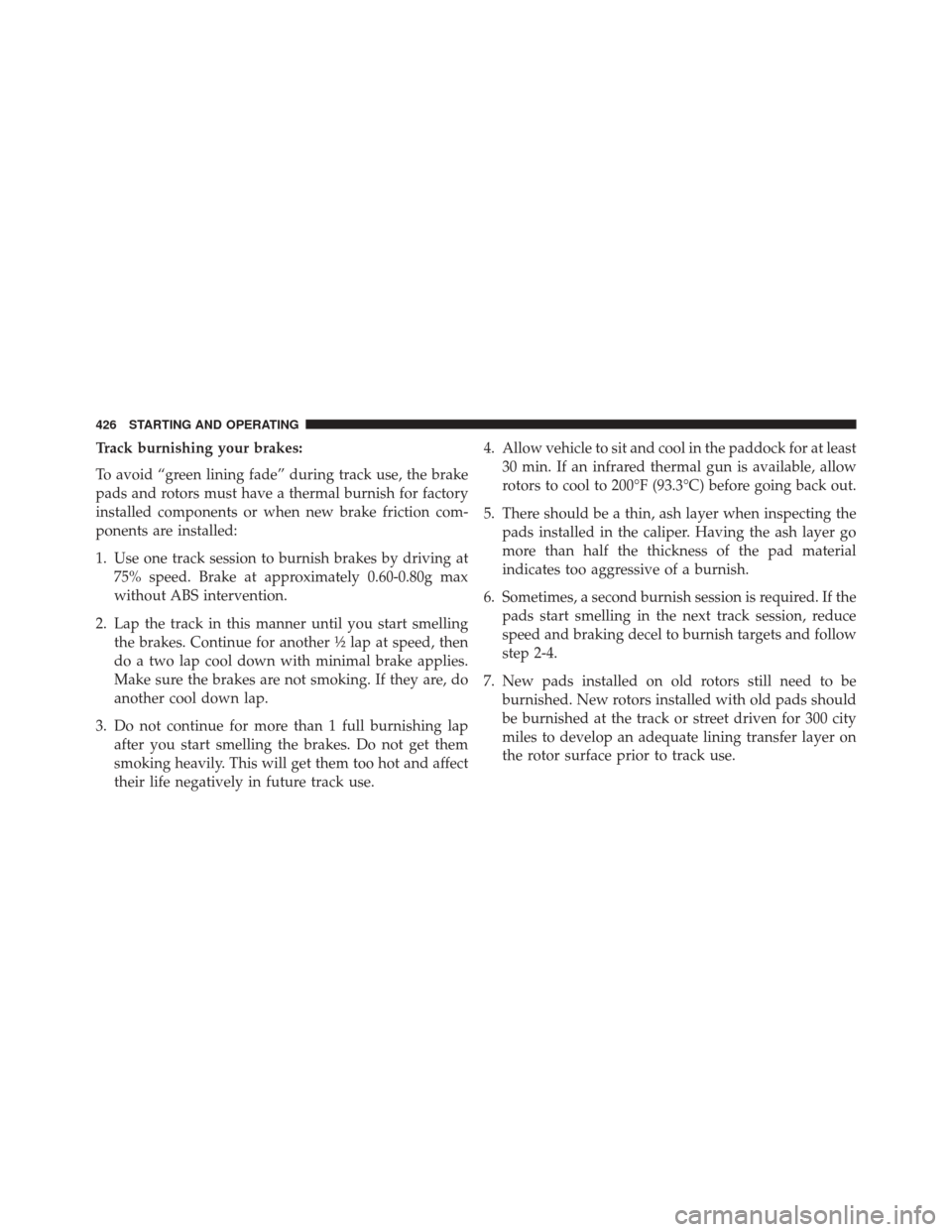
Track burnishing your brakes:
To avoid “green lining fade” during track use, the brake
pads and rotors must have a thermal burnish for factory
installed components or when new brake friction com-
ponents are installed:
1. Use one track session to burnish brakes by driving at75% speed. Brake at approximately 0.60-0.80g max
without ABS intervention.
2. Lap the track in this manner until you start smelling the brakes. Continue for another ½ lap at speed, then
do a two lap cool down with minimal brake applies.
Make sure the brakes are not smoking. If they are, do
another cool down lap.
3. Do not continue for more than 1 full burnishing lap after you start smelling the brakes. Do not get them
smoking heavily. This will get them too hot and affect
their life negatively in future track use. 4. Allow vehicle to sit and cool in the paddock for at least
30 min. If an infrared thermal gun is available, allow
rotors to cool to 200°F (93.3°C) before going back out.
5. There should be a thin, ash layer when inspecting the pads installed in the caliper. Having the ash layer go
more than half the thickness of the pad material
indicates too aggressive of a burnish.
6. Sometimes, a second burnish session is required. If the pads start smelling in the next track session, reduce
speed and braking decel to burnish targets and follow
step 2-4.
7. New pads installed on old rotors still need to be burnished. New rotors installed with old pads should
be burnished at the track or street driven for 300 city
miles to develop an adequate lining transfer layer on
the rotor surface prior to track use.
426 STARTING AND OPERATING
Page 437 of 634

CAUTION!
If the “Brake Warning Light” remains on with the
parking brake released, a brake system malfunction
is indicated. Have the brake system serviced by an
authorized dealer immediately.
BRAKE SYSTEM
Your vehicle is equipped with dual hydraulic brake
systems. If either of the two hydraulic systems loses
normal capability, the remaining system will still func-
tion. There will be some loss of overall braking effective-
ness. This may be evident by increased pedal travel
during application, greater pedal force required to slow
or stop, and potential activation of the “Brake Warning
Light”.
In the event power assist is lost for any reason (for
example, repeated brake applications with the engineOFF), the brakes will still function. The effort required to
brake the vehicle will be much greater than that required
with the power system operating.
NOTE:
Your vehicle is equipped with a high perfor-
mance braking system. The brake pads are a semi-
metallic compound, which offer superior fade resistance
for consistent operation. A compromise to using this type
of brake pad is that the brakes may produce more brake
dust and may squeal slightly under certain weather and
operating conditions (i.e., during light brake applica-
tions) this is considered normal conditions.
ELECTRONIC BRAKE CONTROL SYSTEM
Your vehicle is equipped with an advanced Electronic
Brake Control system (EBC). This system includes Elec-
tronic Brake Force Distribution (EBD), Anti-Lock Brake
System (ABS), Brake Assist System (BAS), Hill Start
Assist (HSA), Traction Control System (TCS), Electronic
Stability Control (ESC), and Electronic Roll Mitigation
5
STARTING AND OPERATING 435
Page 438 of 634
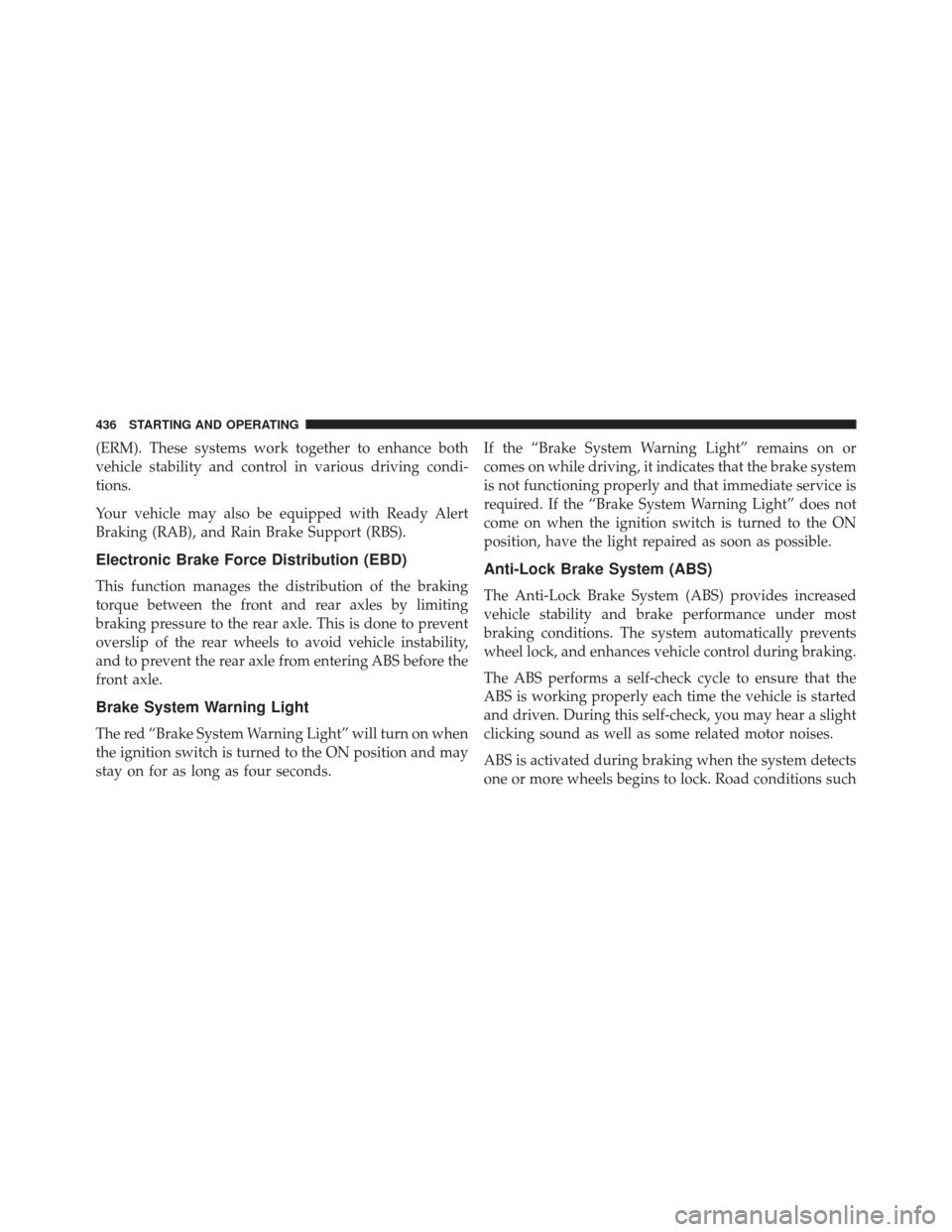
(ERM). These systems work together to enhance both
vehicle stability and control in various driving condi-
tions.
Your vehicle may also be equipped with Ready Alert
Braking (RAB), and Rain Brake Support (RBS).
Electronic Brake Force Distribution (EBD)
This function manages the distribution of the braking
torque between the front and rear axles by limiting
braking pressure to the rear axle. This is done to prevent
overslip of the rear wheels to avoid vehicle instability,
and to prevent the rear axle from entering ABS before the
front axle.
Brake System Warning Light
The red “Brake System Warning Light” will turn on when
the ignition switch is turned to the ON position and may
stay on for as long as four seconds.If the “Brake System Warning Light” remains on or
comes on while driving, it indicates that the brake system
is not functioning properly and that immediate service is
required. If the “Brake System Warning Light” does not
come on when the ignition switch is turned to the ON
position, have the light repaired as soon as possible.
Anti-Lock Brake System (ABS)
The Anti-Lock Brake System (ABS) provides increased
vehicle stability and brake performance under most
braking conditions. The system automatically prevents
wheel lock, and enhances vehicle control during braking.
The ABS performs a self-check cycle to ensure that the
ABS is working properly each time the vehicle is started
and driven. During this self-check, you may hear a slight
clicking sound as well as some related motor noises.
ABS is activated during braking when the system detects
one or more wheels begins to lock. Road conditions such
436 STARTING AND OPERATING
Page 439 of 634
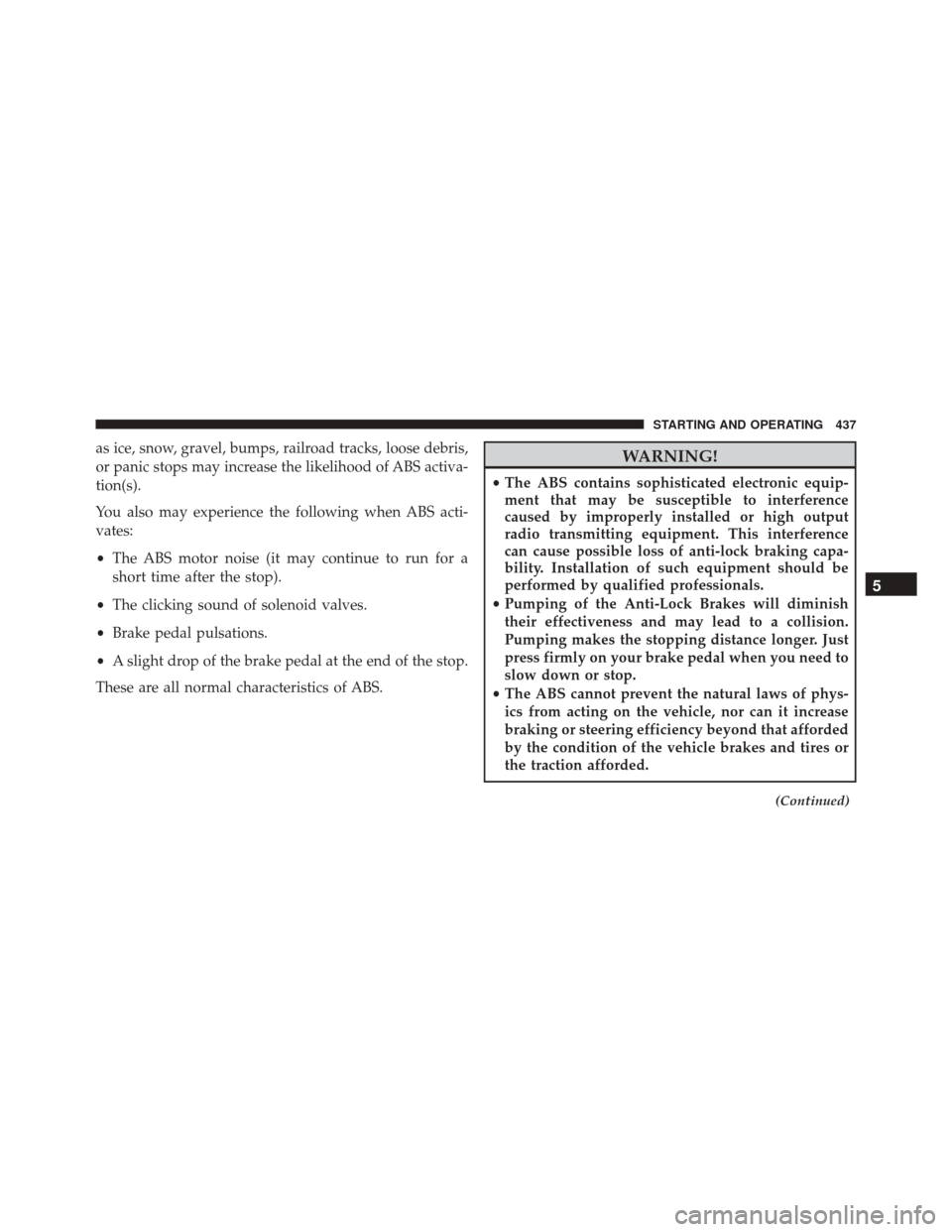
as ice, snow, gravel, bumps, railroad tracks, loose debris,
or panic stops may increase the likelihood of ABS activa-
tion(s).
You also may experience the following when ABS acti-
vates:
•The ABS motor noise (it may continue to run for a
short time after the stop).
• The clicking sound of solenoid valves.
• Brake pedal pulsations.
• A slight drop of the brake pedal at the end of the stop.
These are all normal characteristics of ABS.WARNING!
• The ABS contains sophisticated electronic equip-
ment that may be susceptible to interference
caused by improperly installed or high output
radio transmitting equipment. This interference
can cause possible loss of anti-lock braking capa-
bility. Installation of such equipment should be
performed by qualified professionals.
• Pumping of the Anti-Lock Brakes will diminish
their effectiveness and may lead to a collision.
Pumping makes the stopping distance longer. Just
press firmly on your brake pedal when you need to
slow down or stop.
• The ABS cannot prevent the natural laws of phys-
ics from acting on the vehicle, nor can it increase
braking or steering efficiency beyond that afforded
by the condition of the vehicle brakes and tires or
the traction afforded.
(Continued)
5
STARTING AND OPERATING 437